![]()
Where once religion was the sole arbiter of Truth, science is seen by the main part of this culture as its leading light, the main source of its descriptions of the world. Science was (and still is, of course) a quest for knowledge in an abstract sense: but its public image, as presented in schools and colleges and in the media, is that of the way to analyse reality, using logic to define and delimit what is real and true (and what is not) in ever more minute detail.
In this context, technology is 'applied science'; religion is seen as an anachronism, poetry and the arts an irrelevance, whilst magic is nowhere to be seen - an aberration of the mind now finally eradicated by the ever-increasing progress of science in its explanations of the world and reality.
Our image of science is that it explains things for us. In fact, science is credited with all change, all advance, all progress. Which, as we shall see, is a little unfair: in reality, science has very little to do with it - and it has very little to do with science as practised. It's all a matter of your point of view.
What we call a point of view is better described as a filter, selecting out of the mass of information, of coincidences, those items that we consider to be valid, to be 'signal' events: everything else is just 'noise'. And yet we choose that filter, that definition of what is real and what is not. In the same way, we let it choose us: we can see only what the filter will let us see; a pair of rose-tinted glasses only shows us a rose-tinted world. If we cannot change the filter, we cannot change the way we see the world.
Yet we face a fundamental paradox. As Stan Gooch put it in a letter to the New Scientist magazine:
| Things have not only to be seen to be believed But also have to be believed to be seen. |
Each point of view seems 'right'; the mistake, perhaps, is in assuming that if you are right, then by definition everyone else must be wrong. As Edward de Bono put it in his book Practical Thinking, 'everyone is always right, but no-one is ever right': they may be right from their own point of view, but they simply do not have the information available to be right in a total sense, to be truly 'objective'. And you can't really be objective, as most public descriptions of science claim to be, if all you have is a point of view. de Bono went on to describe two 'laws of thinking':
| [1] An idea can never make the best use of available information, because that
information trickles in over a period of time. [2] Proof is often no more than a lack of imagination, in failing to see an alternative hypothesis that would equally fit the facts. |
Or, as he put it in a rather less gentle form, 'certainty comes only from a feeble imagination.'
There are plenty of certainties around, pre-packaged ways of viewing the world: the catch is that the real world we experience never quite seems to fit these world-views. A political ideal like the beautiful communard slogan 'from each according to ability, to each according to their need', seems to come out in practice as 'from each according to facility, to each according to their greed'. And religious world-views, for example, have a sad habit of assuming that people are 'perfect' - conforming to some arbitrary ideal - when they just aren't that way inclined.
Another example, the concept of the 'supernatural', is a crucial one to our study. The concept itself is another product of this limited thinking: the assumption that a scientific reductionism can explain everything also implies that the logical structure, the world-view, that it builds also defines and delimits the real world, the natural world. Anything outside of the structure is 'supernatural' - literally, above the natural - and, by a tortuous piece of circular reasoning, cannot exist: except, perhaps, as a product of the imagination.
Yet this distinction is quite artificial: if something is perceived, it's natural. It exists, even if 'only' in imagination - so it's natural. If everything is coincidence, and our perception of events is limited only by what we choose to perceive, then there can be no distinction between real or imaginary, natural or supernatural.
To work on the world as it is experienced, to work on it in different ways, we need to be able to explain the world in a variety of ways: we need to be able to change our point of view.
In the last chapter we saw that coincidence and meaning are quite separate - we can't really say that any thing or any co-incidence can be said to be caused by any other event, point of view or whatever. Anything goes.
The trouble with that concept is that if anything goes, we are left with nothing with which to make sense of the world. Without some way of handling it, we have no way of predicting anything at all, and everything and nothing happens at the same time - a certain recipe for instant insanity. So we need some kind of model which allows us the flexibility to allow anything to happen, yet still operate in something resembling a controlled manner.
One approach which is useful is to separate the information we experience from its interpretation, and describe this content and context each as an axis in a simple two-dimensional diagram. In one direction, we have a spectrum of information, ranging from outer tangible or sensory data, to information we derive from within ourselves, as feelings and intuitions. The other axis describes a range of methods of interpretation, from indefinable value judgements through to the strict true/false analyses of logic: a spectrum of interpretation between value and truth - whatever either of those might mean. The model looks something like this:
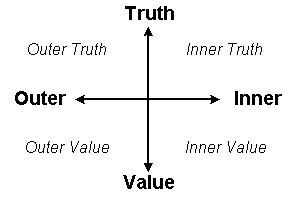
This gives us four quadrants, or modes, in which we both collect information and interpret it: inner value, inner truth, outer truth, outer value. Each of these quadrants is only a way of working on the world, a mode to describe reality as we experience it through using that way of interpreting the world. Reality is, if you like, the sum of everything that could be experienced through these four very different ways of working on the world.
This kind of model of reality can be found in Jung's work, for example; but there is a particularly interesting variant on the theme in SSOTBME, a bizarre book on 'thinking about thinking'. The book was published anonymously, so, for convenience, I shall refer to its author as Leo (a simpler name than his fictitious character Lemuel Johnstone).
Leo builds this model by describing the whole of reality as a swamp. Not a featureless swamp - every point of view, every experience, every possible coincidence of events is included. There are also endless opportunities to wallow in the mires of confusion, and to disappear beneath the surface without trace... It sometimes seems that the safest move would be not to move at all, to stay still. But even that isn't certain: the surface seems to quake with the tide of events, so that even the safest-seeming point of view will seem doubtful after a while. Nothing stays the same for long: indeed, the only real constant is change itself.
As Leo puts it, there are four main ways in which to exist within this kind of reality. Each one coincides with a quadrant of the model above: inner value, inner truth, outer truth, outer value. Each is best described as a mode of operation, in which certain possibilities - such as movement, in this sense of moving from one point of view or one experience to another - exist solely because others - such as stasis, developing one particular point of view - do not occur.
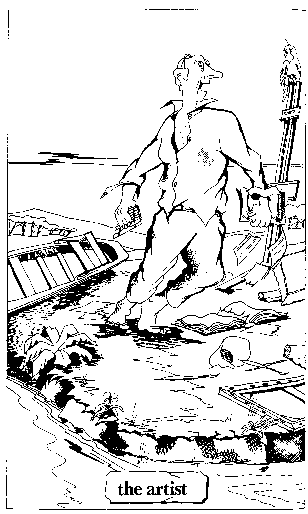 The first way of working
on this world is to skim the surface of the swamp, travelling in a hydroplane at high
speed. The whole point is the speed, and the variety of ideas and experiences that come
from just travelling about with no particular place to go. The first way of working
on this world is to skim the surface of the swamp, travelling in a hydroplane at high
speed. The whole point is the speed, and the variety of ideas and experiences that come
from just travelling about with no particular place to go.This is a mode of inner value, which we could call the artistic mode. Playing with this description a little further, we can see that this is hardly a safe way of operating within a swamp: it's all too easy to crash into some unexpected experience, to run out of fuel (inspiration?), or to decide to settle down in some uncharted spot with no hope of future supplies or common experience shared with anyone else. But it's certainly the quickest way of scanning a wide range of experiences and points of view - although, at that speed, it's not going to be too easy to make sense of anything other than that they were, indeed, experiences and points of view. |
|
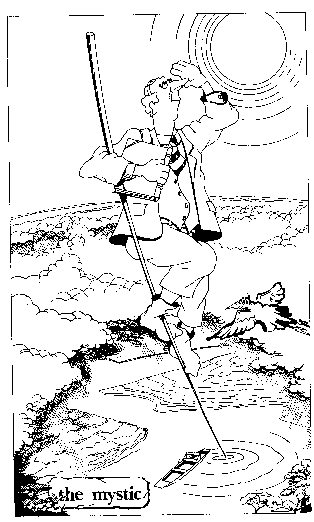 Another modus
operandi seems quite the opposite of the artistic one: to develop one point of view as
far as it will go, right out into another dimension. You state that that point of view is
true - inviolably and absolutely true - and build on it, like a pole in the swamp. Another modus
operandi seems quite the opposite of the artistic one: to develop one point of view as
far as it will go, right out into another dimension. You state that that point of view is
true - inviolably and absolutely true - and build on it, like a pole in the swamp.This is a mode of conviction, of faith, of inner truth - the mystical or religious mode. Again, playing with this image a little further, the higher you climb up the pole, the more of the swamp will come within your view: the more you climb, the more true will seem the point of view. In the distance you can see other poles, other points of view - some of them way out in the distance indeed - but you can hear that experiences from those poles, especially from further up each pole, seems much the same as your own. The mystics, those people who are well and truly up the pole and with their heads in the clouds, can see and share a vast range of vision - even though most of it seems like cloudy thinking to us. The only trouble with this mode is that you can't actually experience anything else, since, by its definition, you have to stay with that one point of view; and it seems a sad fact that each pole has to be counterbalanced by a vast morass of struggling bodies, each of whom has grasped the pole and disappeared beneath the surface, screaming "I have the truth" as they did so.
|
|
 The third mode in this
model is to build a solid platform, a safe predictable area in which everything is true
and inter-related in logic. Everything is patently obvious, there are no surprises on the
platform itself - although around the edges things may not be quite so predictable as they
seem. The third mode in this
model is to build a solid platform, a safe predictable area in which everything is true
and inter-related in logic. Everything is patently obvious, there are no surprises on the
platform itself - although around the edges things may not be quite so predictable as they
seem.This is a world of outer truth, a scientific world. To many people on the platform, the platform itself defines reality, and encompasses the whole of truth. To this point of view, which we could call public-science or 'scientism', anything beyond the platform is unreal; their duty is to build higher and higher walls around the platform, to protect the good citizens from the ignorance and superstition beyond. In fact this has very little to do with science as practised - we could suggest that these are same people who would have screamed "I have the truth" around the poles of religion, except that the solidity of the platform prevents them from decently disappearing beneath the surface as would have happened elsewhere. The platform is woven between a group of poles, more often called the ivory towers of academia; their mystics are the 'pure scientists' whose breadth of vision is matched only by the impenetrability of their thought. And at the edge of the platform are practical scientists, researchers working at the limits of the known world - having discovered, by some means or other, some unintended hole in the fortress walls of scientism. Scientists, says Leo, are like people in wheelchairs - they need firm level ground to move about on. To move, they must extend the platform, extending the boundaries of science, cutting down shady dogmas and filling in soggy hypotheses (to use Leo's graphic image). But when they arrive at some new place, it is just as boring and predictable as anywhere else on the platform - hobgoblins and foul fiends having rushed away at the sound of the first myth being exploded. For the problem with this mode of working is that, by the time it has finished, what it seeks has ceased to be the swamp, has ceased to be reality as it is (or was) - it is just an artificial platform, an 'objective' world with no room for personal experience at all. |
|
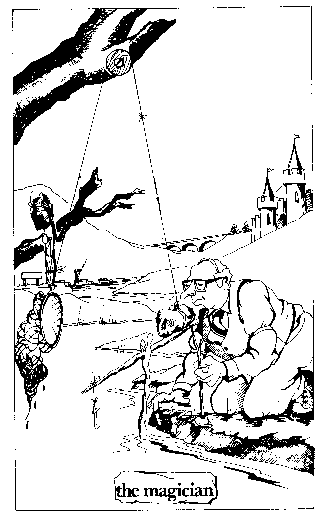 But working away at the
edges of the platform are another group, commonly but quite wrongly called 'applied
scientists'. At one edge you'll find the psychiatrists, not bothering too much about which
theory is absolutely true, but using ideas from Jung, Adler, Freud, Laing and anyone
else's work they can lay their hands on. And at another edge there'll be electrical
engineers switching between wave and particle theories of light and energy, blithely
unconcerned about their mutual incompatibility in logic. But working away at the
edges of the platform are another group, commonly but quite wrongly called 'applied
scientists'. At one edge you'll find the psychiatrists, not bothering too much about which
theory is absolutely true, but using ideas from Jung, Adler, Freud, Laing and anyone
else's work they can lay their hands on. And at another edge there'll be electrical
engineers switching between wave and particle theories of light and energy, blithely
unconcerned about their mutual incompatibility in logic.At first this does look like science, but only because of the safety-line of 'if it doesn't work, go back to theory' - in other words go back to 'outer truth'. But in fact this is a quite different mode, in which you carry the platform with you, spreading your weight on swampshoes to allow you to move with relative freedom from place to place, idea to idea, to find a point of view which is useful at that time, rather than supposedly 'true' in any absolute sense. This is a mode in which truth is defined in terms of whether it has practical value, outer value. We could describe this as a technological mode. But it has an easier label - a magical mode. Whilst there is a real structural difference between technology and science, there is no structural difference between technology and magic. It's entirely true that, as Arthur C. Clarke put it, "any sufficiently advanced technology is indistinguishable from magic". But it's also true that "any sufficiently advanced magic is indistinguishable from technology". They may seem different - sometimes very different - but the underlying approach to reality is exactly the same. The only difference between magic and technology, in practice, is that magicians tend to be a little way out in the distance - they may be seen wandering to astrology, alchemy and other forgotten, part-ruined areas of the old platforms of science, to rest by some religious pole, or travel as fools where angels fear to tread. This mode is hardly safe, as the platform of science may be, but at least it works on the swamp as it is; and the point of the exploring is not to find out how true a belief, a point of view, may be, but to put it to use. |
If we use this model, we can see clearly that technology is not 'applied science'. In fact, it's quite the other way round: in our culture, science is a codified summary of the practical experience of technology, simplified to describe what would happen under nonexistent 'perfect' conditions. Reality is always a little different from the niceties of theory: for example, the pressure-temperature-volume equations, the 'gas laws' we learnt at school, only apply to a perfect gas that doesn't actually exist anywhere in the real world.
One of the biggest problems in technology is not the neat precision of theory, but of getting things to work in the real world. Leo, the writer of SSOTBME, said that one of his problems working as a mathematician in aircraft design was to make his maths sufficiently imprecise to be useful. An important recent advance in computing practice has been the development of 'fuzzy logic' - the mathematics of being precisely imprecise.
Varying tolerances in materials can make a mockery of any design, too. Low-cost versions of electronic components, for example, may be up to twenty percent away from nominal values: multiply that a few times and things can go a long way from the neat predictions of the textbook. One of the real arts of electronic design is in building circuits that cancel out any problems from loose tolerances and lower-cost components. There's a popular truism, too, that defines an engineer - a technologist - as 'someone who can make something well for a pound that any fool can make badly for ten'. In that sense, technology is an art-form in its own right.
And so it goes on. Historically, too, most technology comes before science: intercontinental radio and heavier-than-air aircraft were considered impossible until theory caught up with practice. The idea of scientific research actually driving progress is mostly a myth: far more often it's been someone chasing an idea, or looking for commercial advantage. Technology does the work, but technologists call themselves 'applied scientists' to improve their credibility rating in the academic sweepstakes; science gets the credit.
Science is presented as the controller of a linear progress from idea to hypothesis to theory to law. But we can also see that this is simply another way of looking at the same quadrant diagram:
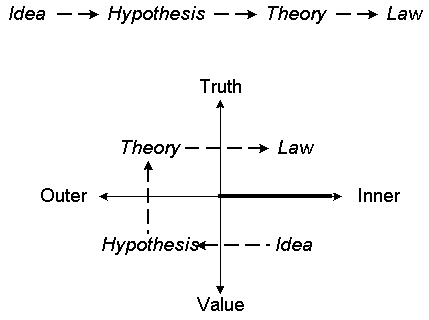
except that a rigid wall has been interposed between the finality of 'scientific law' - 'inner truth' - and the chance of any new ideas. Historically, science has progressed as a sequence of 'scientific revolutions', to use Thomas Kuhn's phrase: the Copernican revolution, the Newtonian revolution, relativistic mechanics and so on. An idea is put into practice as technology, is codified as theory, and frozen as scientific law: and the rigidity and finality of law prevents us from seeing the context in which that 'law' is true. The 'law' is how reality ought to be if the world was perfect: the law tells us God's intentions, as the religious person would put it. Or perhaps it's us telling some God how the world ought to have been made ... ?
What it's really about is explanations. An explanation is a model, a prediction of how something will work. Taken in a wider context, a group of explanations attempt to define how the world 'really works': and if something doesn't fit the explanation, it doesn't exist.
The explanation is seen as being more important than reality, the totality of the swamp. Because the explanation predicts, it makes the world safe. Or seem safe, at any rate. Everything is known, everything is predictable, there is no supernatural, 'I am the Way, the Truth and the Life, there is no way to the Father but by Me', 'there is no God but God, and Mohammed is his prophet...' - which can lead to a rigid state that Edward de Bono described as 'nothing-but-ness'.
A central facet of this kind of closed explanation is the ascription of one unknown to another - a tautology - to prevent any questioning of the belief-system. "There are only four forces in the universe - weak nuclear, strong nuclear, electromagnetic and gravitational; and everything is causally connected", wrote the popular-science writer and pseudoscientist John Taylor, neatly sidestepping the fact that we do not know what any of these forces are, and have no causal explanations even for some key concepts such as radioactive decay.
An explanation is used to 'explain away' anything which doesn't fit. Armchair Freudians use a system so neatly closed that if you say you don't need psycho-analytic treatment, that statement is proof that you need it! And I've had many a battle with the 'religious left' who believe so strongly in democracy that, as the only true representatives of 'the people', only people who agree with them may be allowed to speak or vote - anyone else is, by definition, 'an enemy of the people'.
| A few years ago, ten young Germans became convinced that their country was a
rigid police state. The group, led by Andreas Baader and Ulricke Meinhof, conducted
bombings and 'executions in the name of the people', to fight the cruelty and injustice of
the state as they saw it. The state's response was that all police were mobilised, road blocks and 'search-on-suspicion' orders were imposed throughout the country for years, and civil liberties and legitimate forms of protest were severely curtailed: the characteristics of a police state. Germany hadn't actually been much of a police state when the Baader-Meinhof group started; but it certainly was when they had finished. Their belief system hunted out the 'facts' it needed to 'prove' that its assumptions were true at the end; if the facts didn't exist, it created them. It had no means of testing whether its assumptions were valid in the first place, or whether the actions dictated by those beliefs were appropriate at all. |
When explanations are used in this way, only those things predicted by the belief-system can be seen to happen: which is, of course, the whole point of using an explanation in this way. Remember that 'things have not only to be seen to be believed, but also have to be believed to be seen': so the assumptions about what will happen are also the cause of what does actually happen.
The danger is that while theorists and politicians play at 'what I tell you three times is true' (to quote Lewis Carroll), the real world isn't quite so accommodating. Whilst change is not always for the better, a rigid world-view that cannot cope with change at all will, sooner or later, sink into the swamp, often dragging others with it into insanity beneath the surface.
| The writer Dr Johnson was once standing in a street where the houses came
closer and closer as they reached towards the sky. He saw two women hurling abuse and
vegetables at each other, almost within frying-pan range from the topmost floor of two
houses on opposite sides of the street. "They can never agree", said the good doctor, "for they are arguing from different premises." |
An explanation is a tool, not a 'fact'; it's a way of describing what was perceived. Like technology itself - 'the use of tools and techniques' - we can either use them or, through ignorance, be used by them. It's our choice.
Where people believe that their safety and sanity depend on a belief structure, an explanation-system, that structure is more important than themselves. They no longer direct it: it controls them.
The logic, 'the Truth', that they perceive tying the structure together is like a single thread holding together that platform of science - 'the real world' - linking everything in one unified structure which defines their world-view, their definition of what is 'sane' (literally, 'healthy') and what is not. Break the thread in just one place, though, and the whole complex edifice collapses... and with it their sanity. So it's no wonder people will die for a belief, will go to war over beliefs: structures like this are terrifying fragile.
The world-view becomes rigid, and the social definition of sanity is itself insane: a mad world in which security can only be achieved by the threat of 'mutual assured destruction'. To protect the strand of logic, 'reality' can only be seen in terms of the structure, is in fact defined and delimited in terms of the structure. And we have a tautology: the structure is 'proved' by logic to be true in terms of itself, from its own viewpoint, in order to prove that the logic was, indeed, logical.
But we knew that already: what is the use?
'Use' comes from the context, from 'what is not there'. No doubt you remember, from your school-days, that the sum of angles within a straight-sided triangle is 180°. It's part of the logic of Euclidean geometry. But this is only true for a flat surface, not a spherical one, as many sailors have found to their cost: on a sphere, 'straight' lines are curved into another dimension, and the sum of the enclosed angles may be anything up to 540°. In other geometries the values are even more bizarre: so the truth, the 'right' answer, changes according to the context.
Yet how do you tell, sailing on the sea, whether the world is flat or curved? And if curved, whether it is spherical, or cylindrical, or sausage-shaped, or anything else? Common sense, after all, insists that it is flat; you need a context greater than your immediate perception to understand the idea that the world we stand or sail on is curved. And even that is an assumption - a useful point of view. In any technology that deals with the world as it is, rather than as some theory pre-defines it, anything may be 'true': what matters is its usefulness - whether it is efficient, reliable, elegant and apt.
| "What is matter? And does it?" "Now this", he said, raising his glass, "is a very different matter. And it does!" (advert for Guinness stout, c.1970) |
Where beliefs and points of view are seen as tools rather than final Truths, a world-view is held together by many strands: some may break from changing circumstances, or simply from old age, but the structure as a whole is flexible enough to withstand it. A tatty collection of old ropes of thought may not look so neat as a so-refined single strand of logic, but it least it isn't fragile; the structure may sway a little in the winds of change, but it's not so likely to collapse without warning in the minor earthquake of some 'scientific revolution'.
So, to work on the world as it is, rather than on how some belief defines it to be, we need some way of seeing the context wide enough to select an appropriate point of view. We need to move from explanations that define, to explanations that describe; we need to move from point to point within the swamp, yet have some way of knowing where we are.
We call this process 'learning'. And yet, since to move from belief to belief is unstable, dangerous, we also call it insane. Learning a skill, learning to work with the world in some new way, could also be called 'the subtle art of insanity' - and that's what we'll look at next.
![]()